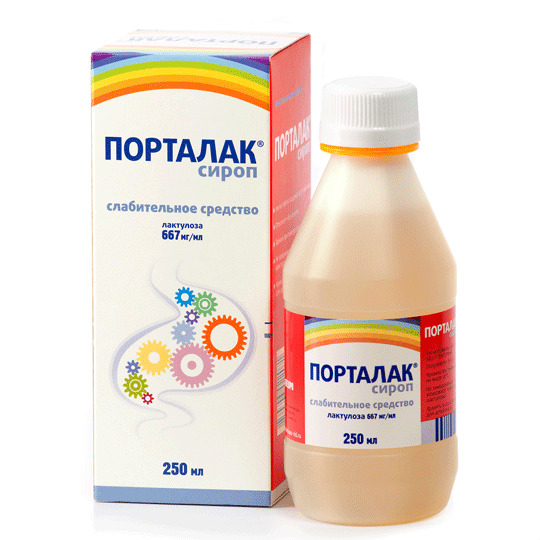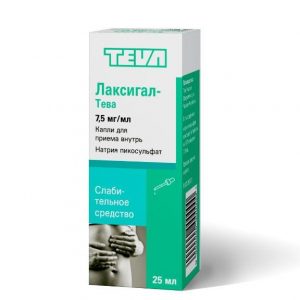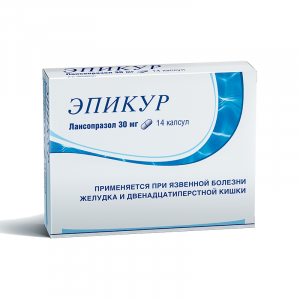Description
Latin name
Portalak
Release form
Syrup
Packing
Bottle 250 ml.
Pharmacological action
Portalac – hypoazotemic, stimulating intestinal motility, laxative.
Pharmacodynamics
Has a hyperosmotic, laxative effect, stimulates intestinal motility, improves the absorption of phosphates and Ca2 + salts, and promotes the excretion of ammonium ions.
Under the influence of lactulose, Lactobacillus acidophilus, Lactobacillus bifidus multiplies in the intestine, which in turn leads to a decrease in pH in the lumen of the colon and activation of its peristalsis. Along with this, the volume increases and the stool softens. The drug has a laxative effect, without directly affecting the mucous membrane and smooth muscles of the large intestine.
Under the influence of lactulose, the formation of nitrogen-containing toxic substances in the proximal colon decreases and their absorption into the systemic circulation.
The concentration of ammonium ions in the blood decreases by 25 50%, reduces the severity of hepatic encephalopathy, improves mental state and normalizes EEG.
The drug has the ability to inhibit the growth of salmonella in the large intestine.
The action of the drug occurs 24 48 hours after ingestion, as the drug passes through the digestive tract.
Pharmacokinetics
Lactulose is practically not absorbed from the gastrointestinal tract (no more than 3% of the accepted dose is absorbed), does not reduce the absorption of vitamins, and is not addictive.
Indications
constipation of various etiologies (including chronic)
the need to soften the stool for medical purposes (with hemorrhoids, the need for surgery on the colon and / or anus, pain syndrome after removal of hemorrhoidal nodes, postoperative period)
intestinal dysbiosis
hepatic encephalopathy
hepatic coma and coma (treatment and prevention)
hyperammonemia
enteritis caused by salmonella, shigellosis syndrome of children, acute poisoning).
Contraindications
hypersensitivity to lactulose or other components of the drug
galactosemia
intestinal obstruction
rectal bleeding (which is not caused by hemorrhoids)
colo- or ileostomy
suspicion.
With caution, the drug is prescribed for patients with gastrocardial syndrome: treatment begins with low doses and increase them gradually, to avoid flatulence.
Due to the presence of small amounts of sugars in the preparation (15 ml of syrup contain up to 1.7 g of galactose and up to 1 g of lactose), care must be taken when prescribing the drug to patients with diabetes mellitus and with lactose intolerance.
Pregnancy and lactation
Lactulose can be used safely in pregnant and lactating mothers.
Composition
100 ml syrup contains:
Active ingredient:
lactulose concentrate66, 7 g
Excipients:
purified water.
Dosage and administration
Portalac is taken orally, in the morning during or after a meal, once or divided into 2 doses, washed down with water or another liquid. The dose of Portalac is selected individually. The initial dose (3 days) is:
Children under 1 year of 5 ml (1 teaspoon)
Children from 1 year to 6 years of 5-10 ml (1-2 teaspoons)
Children from 6 to 14 years 15 ml (1 tablespoon)
Adults 15-45 ml.
Side effects
Side effects are usually mild and reversible and are the result of excess doses.
Cramping, discomfort, or abdominal pain, as well as diarrhea, can be eliminated by reducing the dose. Flatulence that appears at the beginning of treatment, as a rule, disappears after 1-2 days.
Cases of skin reactions (rash) have been reported.
With prolonged therapy and the use of high doses of lactulose in the treatment of hepatic encephalopathy, a violation of the water-electrolyte balance may develop, and as a result, convulsions, nausea, headache, dizziness, arrhythmia, myalgia, fatigue, weakness.
Drug Interaction
No clinically reliable interaction with other drugs was observed when therapeutic doses of lactulose were used. However, it is not recommended to take Portalak ® for 2 hours after receiving another drug.
When taken at the same time, lactulose can interfere with the action of drugs that release an unfavorable environment into the colon (for example, drugs containing mesalazine).
Antibiotics (neomycin) and antacids reduce the effect.
overdose
Symptoms: taking too high doses of the drug can cause diarrhea and impaired electrolyte balance.
Treatment: Withdrawal.
Storage conditions
At a temperature not exceeding 25 ° C.
Shelf suitability
3 Year




